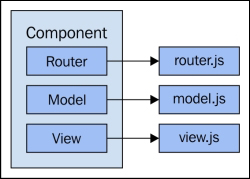Organizing component code
In addition to composing our components in such a way that helps our application scale, we need to consider the structure of our source code modules too. When we first start off with a given project, our source code files tend to map well to what's running in the client's browser. Over time, as we accumulate more features and components, earlier decisions on how to organize our source tree can dilute this strong mapping.
When tracing runtime behavior to our source code, the less mental effort involved, the better. We can scale to more stable features this way because our efforts are focused more on the design problems of the day—the things that directly provide customer value:

The diagram shows the mapping component parts to their implementation artifacts
There's another dimension to code organization in the context of our architecture, and that's our ability to isolate specific code. We should treat our code just like our runtime components, which are self-sustained...
























































